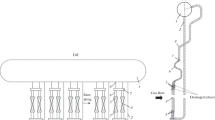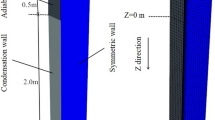Abstract
Experimental temperature profiles and biological kill data from dead-ended tubes of various diameters and lengths commonly used in biotechnology applications were compared to those predicted by a finite element model for steam-in-place (SIP) sterilization at 122°C. Diameter was shown experimentally and numerically to have a significant effect with larger diameter tubes exhibiting greater buoyant driven convective flow and more rapid sterilization. The overall Grashof number was shown to be the significant parameter relating magnitude of convective flow to tube diameter and varied as the diameter cubed. Analysis of air/steam mixture flow patterns showed air displacement from 0.4 cm diameter tubes to be due primarily to molecular diffusion, whereas 1.0 and 1.7 cm tubes showed a two-stage convective flow pattern. There exists a critical diameter of 0.4 cm below which SIP sterilization due to buoyancy driven flow does not occur and steam bleeders should be used.
Similar content being viewed by others
Abbreviations
- Ar:
-
geometric aspect ratio, L/D
- C p :
-
mixture specific heat at constant pressure, J/kg — °C
- C 1 :
-
mass fraction of air
- D :
-
inside tube diameter, m
- D 121C :
-
time to reduce population one log when exposed to saturated steam at 121°C, s
- g :
-
gravitational vector, m/s2
- Gr c :
-
solutal Grashof number, gβ c (C 1H −C 1C )ρ 2 D 3/μ 2
- Gr T :
-
thermal Grashof number, gβ T (T H −T C )ρ 2 D 3/μ 2
- Gr 0v :
-
overall Grashof number, Grc+GrT
- h :
-
convective heat transfer coefficient, W/m2 — °C
- k :
-
mixture thermal conductivity, W/m — °C
- L :
-
tube length, m
- N :
-
buoyancy parameter, Gr cl /Gr T
- P :
-
mixture total absolute pressure, Pa
- Pr :
-
Prandtl number, μc p/k
- P sat :
-
saturated water vapor absolute pressure, Pa
- q :
-
heat flux, W/m2
- R 0 :
-
reference vector in equation (9)
- R :
-
air gas constant, 287.0 J/kg — K
- R(u i ):
-
residual vector in equation (9)
- Sc :
-
Schmidt number, μρα 1
- t :
-
time, s
- T :
-
mixture temperature, °C
- T amb :
-
ambient temperature, °C
- T sat :
-
saturated steam temperature, °C
- u :
-
velocity vector, m/s
- u i :
-
calculated parameter at ith iteration
- u x :
-
x — component of velocity, m/sec
- Z :
-
temperature difference resulting in one log change rate of biological kill, °C
- μ :
-
mixture dynamic viscosity, Pa-s
- ρ :
-
mixture density, kg/m3
- ρ 0 :
-
mixture density at reference temperature and concentration, kg/m3
- ρ sat :
-
saturated water vapor density, kg/m3
- α :
-
binary mass diffusivity, m2/s
- β c :
-
mixture coefficient of concentration expansion
- β T :
-
mixture coefficient of thermal expansion
- ε u :
-
calculated parameter convergence parameter
- ε f :
-
residual tolerance parameter
- H :
-
maximum fluid property
- C :
-
minimum fluid property
References
Pflug, I.J.; Holcomb, R.G.: Principles of thermal destruction of microorganisms. In: Block, S.S. (Ed.): Disinfection, Sterilization and Preservation. 3rd edition, pp. 751–810. Philadelphia: Lea and Febiger 1983
Young, J.H.: Sterilization of varying diameter dead-ended tubes. Biotechnology and Engineering. 42 (1993) 125–132
Young, J.H.; Ferko, B.L.: Temperature profiles and sterilization within a dead-ended tube. J. Parenter. Sci. Technol. 46 (1992) 100–107
Noble, P.T.: Modeling transport processes in sterilization-inplace. Biotechnol. Prog. 8 (1992) 275–284
Murrell, W.G.; Scott, W.V.: The heat resistance of bacterial spores at various water activities. J. Gen. Microbio. 43 (1966) 411–425
Ostrach, S.: Natural convection with combined driving forces. PhysicoChem. Hydro. 1 (1980) 233–247
Lai, W.T.; Ramsey, J.W.: Natural heat and mass transfer in a rectangular enclosure. In: Kim, J.H. and Hassan, Y.H. (Eds): Natural Circulation, Vol. 92, pp. 361–372. New York: ASME 1987
Weaver, J.A.; Viskanta, R.: Natural convection in binary gases due to horizontal thermal and solutal gradients. J. of Heat Transfer. 113 (1991) 141–147
Weaver, J.A.; Viskanta, R.: Natural convection due to horizontal temperature and concentration gradients variable thermophysical property effect. Int. J. Heat Mass Transfer. 34 (1991) 3107–3120
Chin, M.M.: An analytical study of laminar film condensation: part 1-flat plate. J. Heat Transfer. 83 (1961) 48–54
Sparrow, E.M.; Gregg, J.L.: A boundary layer treatment of laminar film condensation. J. Heat Transfer. 81 (1959) 13–18
Mori, Y.; Hijikata, K.: Free convective condensation heat transfer with noncondensable gas on a vertical surface. Int. J. Heat Mass Transfer. 16 (1973) 2229–2240
Sparrow, E.M.; Lin, S.H.: Condensation heat transfer in the presence of a noncondensable gas. J. of Heat Transfer. August (1964) 430–436
Al-Diwany, H.K.; Rose, J.W.: Free convection film condensation of steam in the presence of non-condensing gas. Int. J. Heat Mass Transfer. 16 (1973) 1359–1369
Sparrow, E.M.; Mincowycz, W.J.; Saddy, M.: Forced convection condensation in the presence of non-condensables and interfacial resistance. Int. J. Heat Mass Transfer. 93 (1967) 1829–1838
Shelland, A.H.P.: Diffusional Mass Transfer, pp. 51. New York: Wiley 1974
Charmchi, M.; Martin, J.G.: Natural convective heat transfer, In: Guyer, E.G. (Ed.): Handbook of Applied Thermal Design. pp. 65–67. New York: McGraw-Hill, 1989
Sherman, F.S.: Viscous Flow, pp. 479–481. New York: McGrawHill, 1990
Food and Drug Administration (FDA): Current good manufacturing practice in manufacture, processing, packing and holding of large volume parenterals. Federal Register. 41 (1976) 22207–22219
Seiberling, D.: Clean-in-place and Sterilize-in-place application in the parenteral solutions process. Phar. Eng. 6 (1986) 30–35
Young, J.H.; Ferko, B.L.; Gaber, R.P.: Parameters Governing Steam Sterilization of Deadlegs. J. Parenter. Sci. Technol. 48 (1994) in press
Author information
Authors and Affiliations
Rights and permissions
About this article
Cite this article
Young, J.H., Lasher, W.C. & Gaber, R.P. Transport processes during sterilization of vertical and 5 degree horizontal dead-legs. Bioprocess Engineering 12, 293–304 (1995). https://doi.org/10.1007/BF00369506
Received:
Issue Date:
DOI: https://doi.org/10.1007/BF00369506




